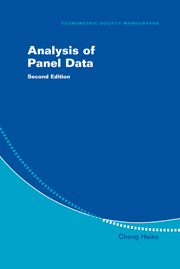Book contents
- Frontmatter
- Contents
- Preface to the Second Edition
- Preface to the First Edition
- Chapter 1 Introduction
- Chapter 2 Analysis of Covariance
- Chapter 3 Simple Regression with Variable Intercepts
- Chapter 4 Dynamic Models with Variable Intercepts
- Chapter 5 Simultaneous-Equations Models
- Chapter 6 Variable-Coefficient Models
- Chapter 7 Discrete Data
- Chapter 8 Truncated and Censored Data
- Chapter 9 Incomplete Panel Data
- Chapter 10 Miscellaneous Topics
- Chapter 11 A Summary View
- Notes
- References
- Author Index
- Subject Index
Chapter 11 - A Summary View
Published online by Cambridge University Press: 14 May 2010
- Frontmatter
- Contents
- Preface to the Second Edition
- Preface to the First Edition
- Chapter 1 Introduction
- Chapter 2 Analysis of Covariance
- Chapter 3 Simple Regression with Variable Intercepts
- Chapter 4 Dynamic Models with Variable Intercepts
- Chapter 5 Simultaneous-Equations Models
- Chapter 6 Variable-Coefficient Models
- Chapter 7 Discrete Data
- Chapter 8 Truncated and Censored Data
- Chapter 9 Incomplete Panel Data
- Chapter 10 Miscellaneous Topics
- Chapter 11 A Summary View
- Notes
- References
- Author Index
- Subject Index
Summary
INTRODUCTION
The preceding chapters have presented a wide variety of analytical tools developed by econometricians for estimating behavioral equations using panel data. In choosing the proper method for exploiting the richness and unique properties of panel data it is helpful to keep several factors in mind. First, what advantages do panel data offer us in investigating economic issues over data sets consisting of a single cross section or time series? Second, what are the limitations of panel data and the econometric methods that have been proposed for analyzing such data? Third, when using panel data, how can we increase the efficiency of parameter estimates? Fourth, the usefulness of panel data in providing particular answers to certain issues depends on the compatibility between the assumptions underlying the statistical inference procedures and the data-generating process.
BENEFITS AND LIMITATIONS OF PANEL DATA
The use of panel data provides major benefits for econometric estimation in at least four areas: (1) increasing degrees of freedom and reducing problems of data multicollinearity, (2) identifying economic models and discriminating between competing economic hypotheses, (3) eliminating or reducing estimation bias, and (4) providing micro foundations for aggregate data analysis. However, the special features of panel data can often create new and difficult econometric problems, particularly in nonlinear models.
Increasing Degrees of Freedom and Lessening the Problem of Multicollinearity
The shortage of degrees of freedom and severe multicollinearity in time-series data often frustrate economists who wish to determine the individual influence of each explanatory variable.
- Type
- Chapter
- Information
- Analysis of Panel Data , pp. 311 - 318Publisher: Cambridge University PressPrint publication year: 2003



